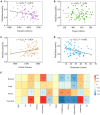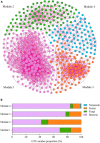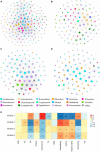Biodiversity of network modules drives ecosystem functioning in biochar-amended paddy soil
- PMID: 38328424
- PMCID: PMC10847562
- DOI: 10.3389/fmicb.2024.1341251
Biodiversity of network modules drives ecosystem functioning in biochar-amended paddy soil
Abstract
Introduction: Soil microbes are central in governing soil multifunctionality and driving ecological processes. Despite biochar application has been reported to enhance soil biodiversity, its impacts on soil multifunctionality and the relationships between soil taxonomic biodiversity and ecosystem functioning remain controversial in paddy soil.
Methods: Herein, we characterized the biodiversity information on soil communities, including bacteria, fungi, protists, and nematodes, and tested their effects on twelve ecosystem metrics (including functions related to enzyme activities, nutrient provisioning, and element cycling) in biochar-amended paddy soil.
Results: The biochar amendment augmented soil multifunctionality by 20.1 and 35.7% in the early stage, while the effects were diminished in the late stage. Moreover, the soil microbial diversity and core modules were significantly correlated with soil multifunctionality.
Discussion: Our analysis revealed that not just soil microbial diversity, but specifically the biodiversity within the identified microbial modules, had a more pronounced impact on ecosystem functions. These modules, comprising diverse microbial taxa, especially protists, played key roles in driving ecosystem functioning in biochar-amended paddy soils. This highlights the importance of understanding the structure and interactions within microbial communities to fully comprehend the impact of biochar on soil ecosystem functioning in the agricultural ecosystem.
Keywords: biochar amendment; core modules; ecosystem functioning; protists; soil microbial biodiversity.
Copyright © 2024 Xiao, Zhou, Qiu, Liu, Chen and Zhang.
Conflict of interest statement
The authors declare that the research was conducted in the absence of any commercial or financial relationships that could be construed as a potential conflict of interest.
Figures







References
-
- Asiloglu R., Shiroishi K., Suzuki K., Turgay O. C., Harada N. (2021). Soil properties have more significant effects on the community composition of protists than the rhizosphere effect of rice plants in alkaline paddy field soils. Soil Biol. Biochem. 161:108397. 10.1016/j.soilbio.2021.108397 - DOI
-
- Bradford M. A., Wood S. A., Bardgett R. D., Black H. I., Bonkowski M., Eggers T., et al. (2014). Discontinuity in the responses of ecosystem processes and multifunctionality to altered soil community composition. Proc. Natl. Acad. Sci. U.S.A. 111 14478–14483. 10.1073/pnas.1413707111 - DOI - PMC - PubMed
LinkOut - more resources
Full Text Sources

